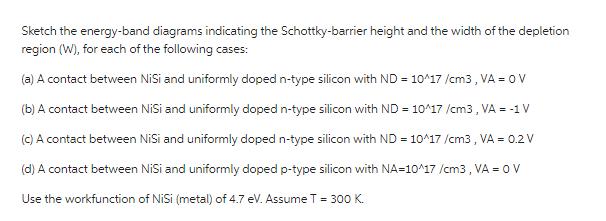Answered step by step
Verified Expert Solution
Question
1 Approved Answer
Sketch the energy-band diagrams indicating the Schottky-barrier height and the width of the depletion region (W), for each of the following cases: (a) A

Sketch the energy-band diagrams indicating the Schottky-barrier height and the width of the depletion region (W), for each of the following cases: (a) A contact between NiSi and uniformly doped n-type silicon with ND = 10^17 /cm3, VA = OV (b) A contact between NiSi and uniformly doped n-type silicon with ND = 10^17 /cm3, VA = -1V (c) A contact between NiSi and uniformly doped n-type silicon with ND = 10^17 /cm3, VA = 0.2 V (d) A contact between NiSi and uniformly doped p-type silicon with NA=10^17 /cm3, VA = 0 V Use the workfunction of NiSi (metal) of 4.7 eV. Assume T = 300 K. Sketch the energy-band diagrams indicating the Schottky-barrier height and the width of the depletion region (W), for each of the following cases: (a) A contact between NiSi and uniformly doped n-type silicon with ND = 10^17 /cm3, VA = OV (b) A contact between NiSi and uniformly doped n-type silicon with ND = 10^17 /cm3, VA = -1V (c) A contact between NiSi and uniformly doped n-type silicon with ND = 10^17 /cm3, VA = 0.2 V (d) A contact between NiSi and uniformly doped p-type silicon with NA=10^17 /cm3, VA = 0 V Use the workfunction of NiSi (metal) of 4.7 eV. Assume T = 300 K.
Step by Step Solution
★★★★★
3.47 Rating (160 Votes )
There are 3 Steps involved in it
Step: 1
The energyband diagrams illustrate the behavior of the energy bands and the formation of the Schottk...
Get Instant Access to Expert-Tailored Solutions
See step-by-step solutions with expert insights and AI powered tools for academic success
Step: 2

Step: 3

Ace Your Homework with AI
Get the answers you need in no time with our AI-driven, step-by-step assistance
Get Started


